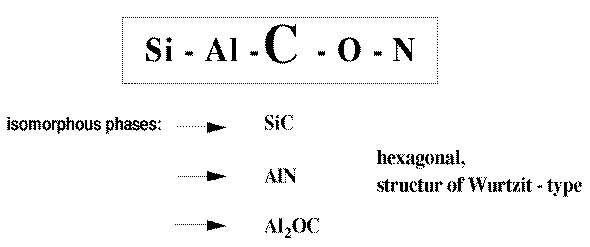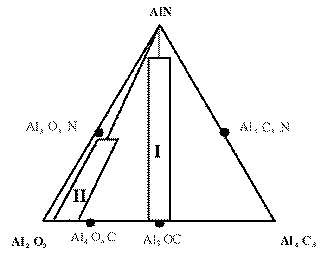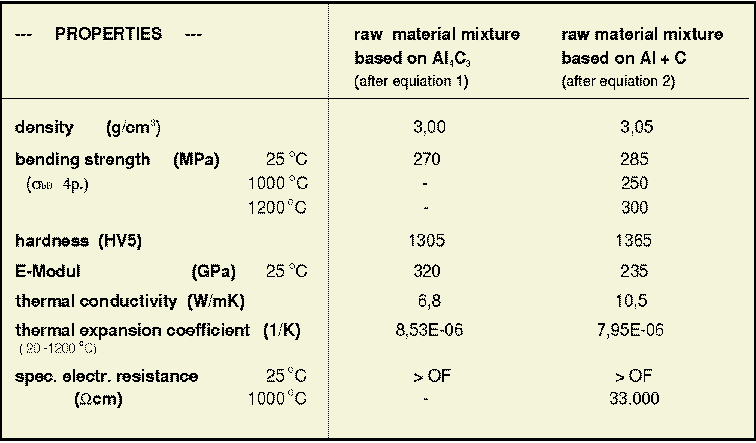
Proceedings of International
Conference Ceramic Processing Science and Technology, 11-14.09.1994, Friedrichshafen
(Germany).
NEW MATERIALS IN THE
AlCON - SYSTEM
A. Schneider, R. Schober
Fraunhofer Institute of Ceramic Technologies and Sintered Materials
Poster located on web-site of Fraunhofer Institute of Ceramic Technologies and Sintered Materials
The recent scientific research in the important field of high temperature corrosive resistant ceramics is connected with the quinary system SiAlCON, in which the SiAlON - system is involved.
Inside the system there are a lot of possibilities to form solid solutions as part of subsidary quaternary systems in the manner as shown in the rectangles of figure 1.

FIG. 1: Formation of the solid solutions in the quinary system Si - Al - C - O - N

FIG. 2: Special interest of this work is directed to the quaternary system Al-C-O-N to improve the high temperature behavior of Al2OC by formation of solid solutions with the isomorphous phase AlN.
Formation, stabilization and characterization of solid solutions of the type (Al2OC)1-x*(AlN)x.
In recent years there were published several research results refering to thermodynanics and formation conditions of stabilized Al2OC / 1-5/. Special information and details one can find in the original literature. The aim of this research is to show a suited way to form the solid solution without hygroscopic Al4C3 and to characterize the properties of the (Al2OC)1-x*(AlN)x . The most important steps can be described as following:
- Investigation of the solid solution formation by reactions according to equation (1) and (2) with AlN - contents from 15 to 70 Mol-%.
- Sintering in defined CO - and N - atmosphere / 6/.
- Analytical and x-ray diffractional methods to characterize the solid solution.
- Measurement of mechanical and physical properties and investigations of the high temperature behavior.

In this case we favorize raw material mixtures according to field I in figure 3 because of a probable Al2OC formation. Furthermore field II is very interesting because of a low temperature eutectic in the pseudoternary phase diagram Al4C3-Al2O3.

FIG.3: Favorized areas for
the solid solution formation
Powders of raw material
mixtures:
AlN: Ventron
Al2O3: Alcoa, CT 3000
Al4C3: Fluca, techn., 90%
Al: Alunova
C: Thermax No. 991
milling:
>> dry homogenization, 1 h
>> ball milling in ethanol, 3h, 500 min-1
hot pressing conditions:
> heating rate: 10 Kmin-1
> temperature: 1800 - 1900�C
> isotherm periode: 60 min
> pressure: 30 MPa
It is possible to synthesize a solid solution (Al2OC)1-x*(AlN)x in a wide range of AlN contents, which appears as one phase by x-ray analysis . The x-ray diffraction pattern of a stabilized solid solution with high AlN-content is shown in fig.4. There is no problem to realize the synthesis based on Al and C after equation (2). The typical variation of the lattice constants between those of Al2OC and AlN is demonstrated in table 1 (d-value for (1 0 0)-peak).
FIG. 4: XRD - pattern of a (Al2OC)1-x * (AlN)x solid solution with 55 Mol-% AlN in raw material mixture.
| Al2OC | 25 AlN | 45 AlN | 55 AlN | 55 AlN | 70 AlN | AlN | |
| d - value (A) | 2,75 | 2,753 | 2,740 | 2,736 | 2,732 | 2,724 | 2,695 |
TAB. 1: Typical variation of lattice constants of the solid solutions between those of (Al2OC)1-x * (AlN)x and AlN (peak 1 0 0 ).
Mechanical and physical properties of the (Al2OC)1-x * (AlN)x solid solution were measured and are shown in table 2. The material appears as typical insulator up to high temperatures.

TAB. 2: Properties of (Al2OC)1-x * (AlN)x solid solution
Investigation of wettability:
The wetting behavior of liquids on solids was investigated in case of
liquid steel (9MnNi4) on solid (Al2OC)1-x* (AlN)x compared with the behavior
of the test materials BN, SiAlON and SiAlON/Corundum/C - composit (Ar
atmosphere, up to 1700�C). In all cases the contact angle (q) shows not
wetting but significant differences in stability against reaction with
the solid (Tab.2). There was no corrosive attack of molten steel on (Al2OC)1-x*(AlN)x
in Ar atmosphere up to 1700�C.
The investigation was carried out by means of a high temperature microscope
of LEICA combined with the measuring system Quantimet 500.


FIG.6: Investigation of wettability, in fig. B - D is shown the melting of steel on solid (Al2OC)1-x* (AlN)x

Wettability of (Al2OC)1-x*(AlN)x substrate material in comparison with BN, SiAlON, SiAlON/Corundum/C composit; melting material: steel (9MnNi4); temperature: 25 - 1700 �C; Ar atmosphere
Stable (Al2OC)1-x*(AlN)x solid
solutions have been verified.
The substitution of the hygroscopic Al4C3 by Al and C is advantageous
for processing.
The material is applicable for refractories and wear resistant usage (bearings).
The material indicates the following properties:
- Electrical non- conductivity (insulator)
- Thermal conductivity can be influenced by material composition
- Thermal stability up to 1200 �C (air) for long time applications and for limited time up to 1700 �C (inert atmosphere)
- Temperature independent bending strength (Sigma bB, 4-p.) up to 1200 �C, SIGMA bB can be increased by optimization of the structure and density.
- L.M.Forster, G.Long, M.S.Hunter, Reactions between Aluminum Oxide and Carbon, J.Am.Ceram.Soc., Vol.39, No.1, 1956, pp. 1-11
- J.M.Lihrmann, T.Zambetakis, M.Daire, The Aluminum Mono-Oxycarbide Al2OC in the System Si-C-Al-O-N: some thermodynamic properties, J.Am.Ceram.Soc. 72 (9) 1704, 1989
- W.Rafaniello, K.Cho, A.V.Virkar, Fabrication and Characterization of SiC-AlN alloys J. Mat.Science 16 (1981) 3479-3488
- S.Y.Kuo, A.V.Virkar, Morphology of Phase Separation in AlN-Al2OC and SiC-AlN Ceramics, J.Am.Ceram.Soc., 73 (9) 2640-46, 1990
- J.-L.Huang, A.C.Hurford, R.A.Cutler, A.V.Virkar Sintering Behaviour and Properties of SiCAlON ceramics J.Mat.Science 21 (1986) 1448 - 1456
- A.Yamaguchi, Affects of Oxygen and Nitrogen Partial Pressure on Stability of Metal, Carbide, Nitride and Oxide in Carbon-Containing Refractories, Taikabutsu Overseas, Vol.7, No.1, pp.4-13